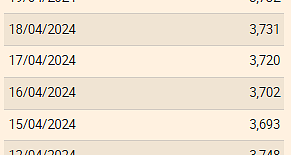Russia's war against Ukraine, drastically higher energy costs and delivery bottlenecks caused by the pandemic have caused the prices of staple foods in Germany to skyrocket - including flour.
"In the meantime, the raw material prices have almost doubled for all types of grain within the last year," explains Peter Haarbeck, Managing Director of the Association of Grain, Milling and Starch Industries (VGMS). In the calculations of the mills, grain makes up almost 80 percent of the total costs. But the price of electricity has at least doubled for companies.
There are other problems too. "The grain balances are very tight worldwide and the forecasts for the coming harvest for important growing countries are not particularly good," says Haarbeck. "Demand exceeds production." Climate change is making harvests more uncertain overall. Because Ukraine and Russia account for around 30 percent of global wheat trade, there is also a risk of uncertainty here.
In addition, the current crises are causing states to stock up on supplies in order to ensure food supplies for their populations. “In our view, none of this will lead to an easing of tension on the grain markets. There are many indications that the price of wheat, and subsequently all other grains, will remain high.”
However, the head of the mill association does not see a shortage of flour or even bread in this country. "The demand for bread grain - wheat, rye and spelt - in Germany can be easily covered from domestic cultivation," emphasizes Haarbeck.
On average in recent years, the self-sufficiency level for soft wheat, which is used for bread and other baked goods, was 125 percent. And despite the persistent drought, the current harvest estimates are not bad either. "The flour supply for the bakers is secured."
According to Guido Seedler, grain market expert at the German Raiffeisen Association, the German surplus is urgently needed. Failures in global supply are programmed. These could only be compensated for by the EU. "In our estimation, the German grain industry will be able to make more bread wheat available to the world market in the coming year," says Seedler.
Grain is almost exclusively exported, but hardly any flour. The approximately 550 German mills - including 185 that grind more than 1000 tons of grain per year - produce about 6.8 million tons of flour and other milled products for domestic needs from about 8.3 million tons of grain. 68 percent of the processed grain even stays in the federal state in which the mill is located.
With four million tons of wheat flour type 550 - the preferred baker's flour for light breads and rolls - is the front runner. Then comes the typical household and confectionery wheat flour Type 405 with 800,000 tons. Around 320,000 tonnes of this was sold in small packs via retailers last year.
According to VGMS, almost 30 percent of the ground products go to artisan bakers, around 55 percent to companies in the baked goods and food industry and around ten percent to special processors such as pasta and noodle manufacturers.

 The Euribor today remains at 3.734%
The Euribor today remains at 3.734% Germany: the trial of an AfD leader, accused of chanting a Nazi slogan, resumes this Tuesday
Germany: the trial of an AfD leader, accused of chanting a Nazi slogan, resumes this Tuesday New York: at Columbia University, the anti-Semitic drift of pro-Palestinian demonstrations
New York: at Columbia University, the anti-Semitic drift of pro-Palestinian demonstrations What is Akila, the mission in which the Charles de Gaulle is participating under NATO command?
What is Akila, the mission in which the Charles de Gaulle is participating under NATO command? What High Blood Pressure Does to Your Body (And Why It Should Be Treated)
What High Blood Pressure Does to Your Body (And Why It Should Be Treated) Vaccination in France has progressed in 2023, rejoices Public Health France
Vaccination in France has progressed in 2023, rejoices Public Health France Food additives suspected of promoting cardiovascular diseases
Food additives suspected of promoting cardiovascular diseases “Even morphine doesn’t work”: Léane, 17, victim of the adverse effects of an antibiotic
“Even morphine doesn’t work”: Léane, 17, victim of the adverse effects of an antibiotic MEPs validate reform of EU budgetary rules
MEPs validate reform of EU budgetary rules “Public Transport Paris 2024”, the application for Olympic Games spectators, is available
“Public Transport Paris 2024”, the application for Olympic Games spectators, is available Spotify goes green in the first quarter and sees its number of paying subscribers increase
Spotify goes green in the first quarter and sees its number of paying subscribers increase Xavier Niel finalizes the sale of his shares in the Le Monde group to an independent fund
Xavier Niel finalizes the sale of his shares in the Le Monde group to an independent fund Owner of Blondie and Shakira catalogs in favor of $1.5 billion offer
Owner of Blondie and Shakira catalogs in favor of $1.5 billion offer Cher et Ozzy Osbourne rejoignent le Rock and Roll Hall of Fame
Cher et Ozzy Osbourne rejoignent le Rock and Roll Hall of Fame Three months before the Olympic Games, festivals and concert halls fear paying the price
Three months before the Olympic Games, festivals and concert halls fear paying the price With Brigitte Macron, Aya Nakamura sows new clues about her participation in the Olympics
With Brigitte Macron, Aya Nakamura sows new clues about her participation in the Olympics Skoda Kodiaq 2024: a 'beast' plug-in hybrid SUV
Skoda Kodiaq 2024: a 'beast' plug-in hybrid SUV Tesla launches a new Model Y with 600 km of autonomy at a "more accessible price"
Tesla launches a new Model Y with 600 km of autonomy at a "more accessible price" The 10 best-selling cars in March 2024 in Spain: sales fall due to Easter
The 10 best-selling cars in March 2024 in Spain: sales fall due to Easter A private jet company buys more than 100 flying cars
A private jet company buys more than 100 flying cars This is how housing prices have changed in Spain in the last decade
This is how housing prices have changed in Spain in the last decade The home mortgage firm drops 10% in January and interest soars to 3.46%
The home mortgage firm drops 10% in January and interest soars to 3.46% The jewel of the Rocío de Nagüeles urbanization: a dream villa in Marbella
The jewel of the Rocío de Nagüeles urbanization: a dream villa in Marbella Rental prices grow by 7.3% in February: where does it go up and where does it go down?
Rental prices grow by 7.3% in February: where does it go up and where does it go down? Europeans: “All those who claim that we don’t need Europe are liars”, criticizes Bayrou
Europeans: “All those who claim that we don’t need Europe are liars”, criticizes Bayrou With the promise of a “real burst of authority”, Gabriel Attal provokes the ire of the opposition
With the promise of a “real burst of authority”, Gabriel Attal provokes the ire of the opposition Europeans: the schedule of debates to follow between now and June 9
Europeans: the schedule of debates to follow between now and June 9 Europeans: “In France, there is a left and there is a right,” assures Bellamy
Europeans: “In France, there is a left and there is a right,” assures Bellamy These French cities that will boycott the World Cup in Qatar
These French cities that will boycott the World Cup in Qatar Serie A: Bologna surprises AS Rome in the race for the C1
Serie A: Bologna surprises AS Rome in the race for the C1 Serie A: Marcus Thuram king of Italy, end of the debate for the position of number 9 with the Blues?
Serie A: Marcus Thuram king of Italy, end of the debate for the position of number 9 with the Blues? Milan AC-Inter Milan: Thuram and Pavard impeccable, Hernandez helpless… The tops and flops of the derby
Milan AC-Inter Milan: Thuram and Pavard impeccable, Hernandez helpless… The tops and flops of the derby Ligue 2: Auxerre leader, Bordeaux in crisis, play-offs... 5 questions about an exciting end of the season
Ligue 2: Auxerre leader, Bordeaux in crisis, play-offs... 5 questions about an exciting end of the season


















